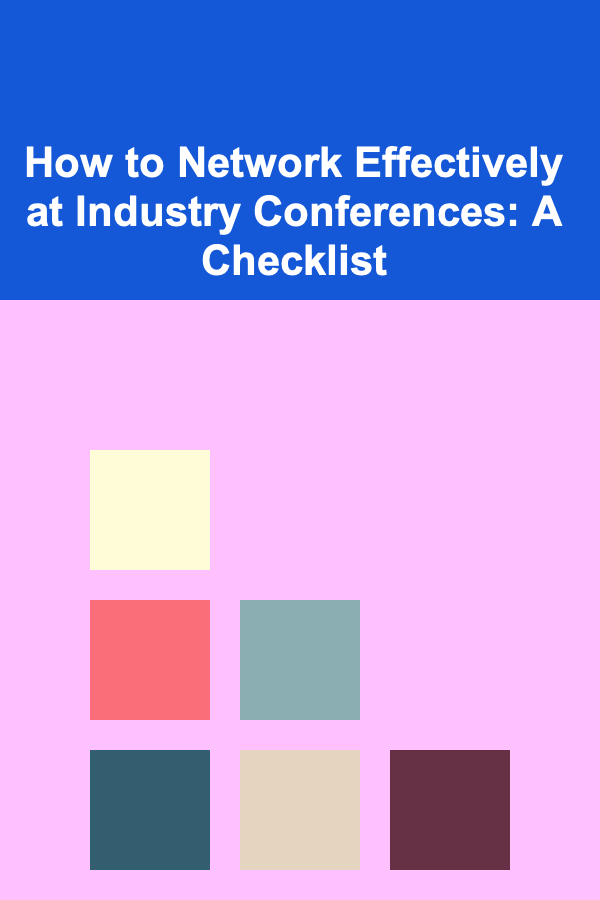
How to Network Effectively at Industry Conferences: A Checklist
ebook include PDF & Audio bundle (Micro Guide)
$12.99$7.99
Limited Time Offer! Order within the next:

Industry conferences are some of the best places to connect with professionals, discover new opportunities, and gain knowledge about the latest trends and technologies in your field. Networking at these events, however, is not simply about collecting business cards or handing out your own; it's about building meaningful relationships that can contribute to your long-term career development.
To network effectively at industry conferences, you need more than just enthusiasm. You need to be strategic, prepared, and focused on making genuine connections. This checklist provides essential tips and strategies that will help you navigate the event, make the most of your time, and leave with valuable contacts.
Set Clear Goals Before You Attend
The first step in effective networking is understanding what you want to achieve. If you attend a conference without clear objectives, you risk spending your time wandering aimlessly, meeting the wrong people, or missing opportunities.
Action Steps:
- Define your purpose: Are you looking for new clients, potential business partners, industry insights, job opportunities, or simply a chance to learn? Be clear about your goals.
- Target specific individuals or companies: Research the list of attendees or speakers in advance and identify key individuals or companies you want to connect with. LinkedIn or event apps can often give you this information.
- Plan your time wisely: Prioritize events or sessions that align with your goals. For example, if you're interested in finding collaborators for a project, attending a specific networking event or workshop may be more beneficial than sitting in a general lecture.
Having clear goals will keep you focused and allow you to make the most of your conference experience.
Prepare Your Elevator Pitch
One of the most essential tools in networking is your elevator pitch. This concise, clear, and compelling introduction can make a great first impression and spark meaningful conversations with potential contacts.
Action Steps:
- Craft a concise introduction: Your pitch should cover who you are, what you do, and what you're looking for in a succinct and engaging way. The goal is to make it interesting enough to encourage follow-up questions.
- Personalize your pitch: Tailor your elevator pitch to the context of the conference and the person you're speaking to. If you know you're talking to someone in a specific industry, adjust your message accordingly.
- Keep it under 30 seconds: An elevator pitch should be quick and to the point. Practice your pitch in front of a mirror or with a friend until it feels natural and comfortable.
A well-prepared pitch will help you make an impact and leave a lasting impression on the people you meet.
Make a Good First Impression
The first few moments of any conversation are crucial. You need to establish trust and rapport quickly, especially in the context of a busy conference environment where you might be meeting dozens of new people.
Action Steps:
- Dress appropriately: Your appearance plays a big role in how you're perceived. Dress professionally and in a way that suits the conference setting and the people you're meeting.
- Smile and make eye contact: A friendly, approachable demeanor will make others feel comfortable. A warm smile and direct eye contact create an inviting atmosphere.
- Have good body language: Your body language speaks volumes. Avoid crossing your arms or checking your phone while talking. Maintain an open posture, and use gestures to convey your enthusiasm.
By making a positive first impression, you'll open the door to more meaningful interactions.
Leverage Social Media and Conference Apps
Social media and event-specific apps are powerful tools that can significantly enhance your networking opportunities. By engaging with these platforms, you can increase your visibility, identify potential contacts, and stay updated on conference activities.
Action Steps:
- Follow event hashtags: Many conferences have a dedicated hashtag that attendees use to share insights, experiences, and updates. Engage with these posts to get a sense of the event's atmosphere and to identify others you may want to connect with.
- Use LinkedIn: LinkedIn is a fantastic tool for networking, especially before and after the event. Send connection requests to speakers, attendees, or exhibitors you meet, and include a personalized message that references your interaction at the conference.
- Use conference apps: Many conferences now have mobile apps that allow you to view attendee lists, connect with others, and keep track of schedules. Don't hesitate to use these apps to set up meetings or make connections in advance.
By leveraging social media and event apps, you can enhance your networking efforts and stay connected beyond the conference.
Attend Networking Events and Breakout Sessions
Conferences often have specific networking events, such as cocktail hours, dinners, or meet-and-greet sessions, designed for attendees to interact in a more relaxed setting. These events can be invaluable for making connections in a less formal atmosphere.
Action Steps:
- Research the networking events: Before the conference, check the event schedule for networking sessions. These are often prime opportunities to meet like-minded individuals or potential business partners.
- Be active in breakout sessions: When attending workshops or panels, engage actively in discussions. Ask thoughtful questions, contribute to conversations, and make yourself visible as someone who adds value to the session.
- Be strategic with your time: Don't try to attend everything. Instead, focus on networking events where you're most likely to meet people who align with your goals.
Networking events provide opportunities to build relationships in a more relaxed environment, so don't overlook these chances to connect.
Ask Questions and Listen Actively
Networking is a two-way street. While it's important to share information about yourself, it's equally important to listen to others. By asking the right questions and listening actively, you can learn more about the people you meet, their work, and how you might collaborate in the future.
Action Steps:
- Ask open-ended questions: Rather than asking yes/no questions, pose questions that encourage the other person to elaborate on their experiences, challenges, and goals.
- Practice active listening: Pay full attention when the other person is speaking. Nod in agreement, make eye contact, and avoid interrupting. Respond thoughtfully to show that you're engaged.
- Take notes: After each conversation, jot down key details, such as the person's role, company, and any follow-up actions. This will help you remember the conversation and personalize future interactions.
Active listening and asking the right questions can turn a casual conversation into a valuable networking opportunity.
Follow Up After the Conference
Networking doesn't end when the conference is over. Following up with the people you met is essential to maintaining and strengthening the connections you made. A prompt follow-up shows professionalism and reinforces the relationship.
Action Steps:
- Send a personalized message: Within 24 to 48 hours after the conference, send a LinkedIn message or email to the people you met. Reference something specific from your conversation to jog their memory.
- Be clear about your intentions: If you want to continue the conversation or explore potential collaboration, be direct about your interest. Include a call to action, such as scheduling a follow-up meeting or call.
- Offer value: If appropriate, share something useful (e.g., a relevant article, a business opportunity, or an industry report) that aligns with their interests. This shows that you're thinking about how to help them, not just yourself.
A well-crafted follow-up message can cement your new relationship and set the stage for future collaboration.
Be Authentic and Build Trust
One of the most important aspects of effective networking is building trust. People want to work with those who are genuine, authentic, and reliable. Focus on creating real connections rather than trying to sell yourself or your business.
Action Steps:
- Be yourself: Don't try to be someone you're not just to impress others. Authenticity is key to forming meaningful connections that will last.
- Offer help: Instead of immediately asking for something, offer assistance or share valuable insights. Being helpful shows that you're invested in the relationship.
- Build rapport over time: Trust isn't built in a single conversation. Take the time to nurture relationships and stay in touch over the long term.
Building trust through authentic connections is far more valuable than simply exchanging contact information.
Respect Others' Time
While networking is important, it's also crucial to be mindful of other people's time. Conferences are often busy events, and attendees may have tight schedules or multiple people they need to meet.
Action Steps:
- Keep conversations brief: Respect others' time by keeping your conversations focused and brief. If you see they are trying to move on, gracefully wrap up the discussion and offer to connect later.
- Schedule meetings in advance: If you want to have a more in-depth conversation, schedule a meeting outside the conference hours. This gives both parties time to engage fully without distractions.
By respecting others' time, you demonstrate professionalism and courtesy, which are vital for long-term networking success.
Stay Positive and Be Patient
Networking doesn't always lead to immediate results. Some of the most valuable relationships may take time to develop, and it's important to stay patient and positive throughout the process.
Action Steps:
- Maintain a positive attitude: Even if things don't go as planned, maintain a positive outlook. A positive attitude will make you more approachable and will leave a lasting impression.
- Be patient: Building strong networks takes time. Not every conversation will turn into an immediate opportunity, but if you stay consistent and nurture relationships, good things will come.
By staying positive and patient, you'll cultivate a network that continues to grow and provide value over time.
Conclusion
Effective networking at industry conferences is about more than just making a lot of contacts. It's about building genuine, meaningful relationships that can support your career and professional development in the long run. By setting clear goals, preparing in advance, engaging actively, and following up strategically, you can maximize your networking efforts and leave a lasting impact at your next conference.
So, get ready to attend your next industry event with confidence, armed with the knowledge and tools to network effectively and build a robust professional network.
Reading More From Our Other Websites
- [Personal Care Tips 101] How to Apply Hair Oil Before Styling
- [Personal Finance Management 101] How to Use Financial Apps to Simplify Money Management
- [Home Staging 101] How to Stage a Home with Neutral Tones to Appeal to More Buyers
- [Home Renovating 101] How to Achieve a Stunning Small Bathroom Remodel on a Tiny Budget
- [Home Budget Decorating 101] How to Achieve Frugal Home Styling: A Guide to Creating High-End Looks Without Breaking the Bank
- [Personal Care Tips 101] How to Choose Sunscreen That Works Well for Your Skin's Needs
- [Home Storage Solution 101] How to Store Seasonal Clothes Without Taking Up Space
- [Home Cleaning 101] How to Tidy Up Your Bedroom and Keep It Organized
- [Personal Investment 101] How to Invest in Cryptocurrency for the Long-Term
- [Home Holiday Decoration 101] How to Style Your Holiday Tree with Unique Ornaments

How to Build a Checklist for Holiday Tree Decorating
Read More
How to Check and Replace Refrigerator Filters
Read More
How to Choose the Right Laundry Space Saver Storage Rack
Read More
How to Cut Down on Subscription Costs for Home Services
Read More
What Are the Benefits of Using Clear Storage Bins?
Read More
How To Appreciate the Raw Energy of Garage Rock
Read MoreOther Products

How to Build a Checklist for Holiday Tree Decorating
Read More
How to Check and Replace Refrigerator Filters
Read More
How to Choose the Right Laundry Space Saver Storage Rack
Read More
How to Cut Down on Subscription Costs for Home Services
Read More
What Are the Benefits of Using Clear Storage Bins?
Read More